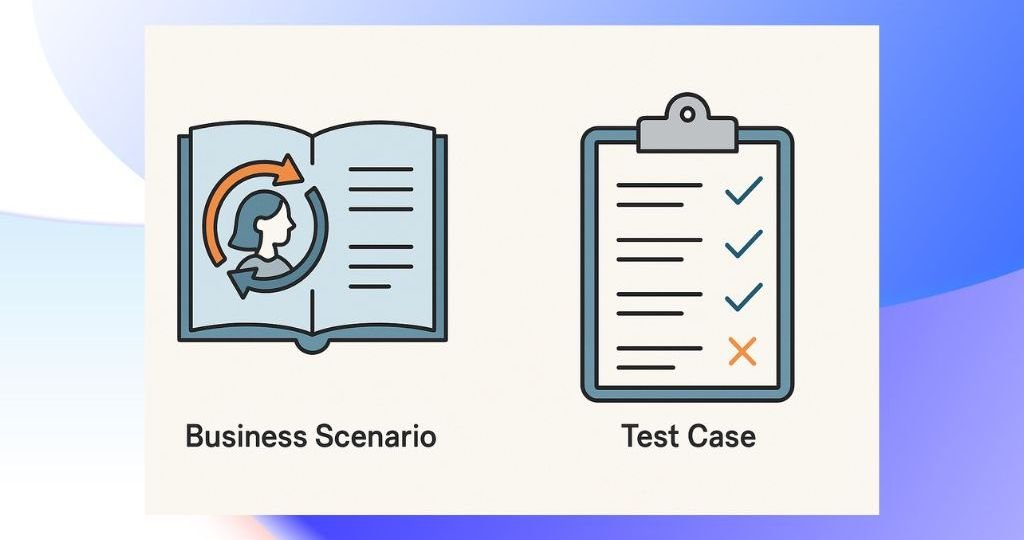
In IT projects, especially Agile environments, we often hear terms like business scenario, test case, user story, or acceptance criteria used interchangeably. But when it comes to aligning technical outcomes with business goals, understanding the difference between business scenarios and test cases is crucial — because precision truly matters.
As a Product Owner or Business Analyst, you play a critical role in helping teams understand not only what to build, but also how it should behave in the real world. That’s where the distinction between business scenarios and test cases becomes essential.
So what exactly is the difference? Let’s unpack the difference between business scenarios and test cases.
💡 What Is a Business Scenario?
A business scenario is a real-world narrative that describes how a user or system interacts with the product in a specific context to achieve a goal.
Think of it as a story with context: it paints a picture of a complete use case from the user’s point of view.
🔍 Characteristics of a Business Scenario:
- Describes a realistic workflow
- Includes roles, triggers, decisions, exceptions
- Focuses on business value and goals
- Often used during requirements gathering, workshops, or UAT preparation
- Written in natural language, not formal structure
📝 Example:
A patient from Namur logs into the medical appointment app to book a gynecology appointment. She selects her preferred date and time, sees available slots, and receives a confirmation by email. Later, she logs back in to reschedule due to a work conflict.
This scenario tells us:
- Who the user is
- What they want to do
- Which features are involved
- What exceptions may arise
🧪 What Is a Test Case?
A test case is a structured, step-by-step set of instructions designed to verify that a specific feature or function of the system works as expected.
It’s part of the formal testing process, usually maintained by QA teams, and tied to system requirements or acceptance criteria.
🔍 Characteristics of a Test Case:
- Is formal and structured
- Includes inputs, actions, expected results
- Focuses on verifying system behavior
- Can be automated or manual
- Used in QA cycles: unit testing, system testing, regression, etc.
📝 Example:
| Step | Action | Expected Result |
|---|---|---|
| 1 | Log in as a patient | Login successful |
| 2 | Select gynecology specialty | List of available doctors is displayed |
| 3 | Choose date and time | Time slot is reserved |
| 4 | Click confirm | Confirmation email is sent |
This format ensures repeatability and traceability during testing.
🆚 Business Scenario vs Test Case: A Side-by-Side View
| Feature | Business Scenario | Test Case |
|---|---|---|
| Purpose | Understand business flow | Verify functionality |
| Language | Natural, story-like | Structured, technical |
| Format | Narrative | Step-by-step |
| Written by | PO, BA, end users | QA/testers |
| Used in | Discovery, UAT, design | QA cycles |
| Focus | Business value & context | Expected system behavior |
👩💻 Why BAs and POs Should Use Both
As a Business Analyst or Product Owner, you’re the bridge between users and technical teams. Business scenarios help you:
- Capture user expectations
- Identify edge cases and exceptions
- Communicate effectively with stakeholders
Meanwhile, understanding test cases helps you:
- Write testable user stories
- Collaborate better with QA
- Ensure what’s delivered meets business needs
✅ Quick Tips for Your Practice
- Start with scenarios in discovery or refinement sessions.
- Translate scenarios into acceptance criteria, then support QA in converting them into test cases.
- Involve users in writing UAT scenarios based on real-world tasks.
- Don’t confuse completeness with complexity: clarity wins.
🔚 Conclusion
Understanding the difference between business scenarios and test cases is essential for anyone involved in delivering successful IT projects. Business scenarios help us understand the context, user goals, and real-life workflows, while test cases provide the structured validation needed to confirm that the system behaves as expected.
By integrating both into your analysis and development processes, you not only reduce ambiguity and risk — you also ensure that your solutions are technically sound and truly aligned with business needs. In short, combining these two perspectives helps deliver products that work and make sense to the people who use them.
You might also be interested in our another article: “The Product Owner in IT: The Bridge Between Vision and Execution” and “Product Owner’s Daily Routine: Balancing Priorities in IT Projects“
Feel free to share this article on your social media — and if you have any questions, don’t hesitate to reach out to us by email. We’d be happy to hear from you!
✨ Follow our Pinterest page regularly for visual inspiration and fresh ideas.

